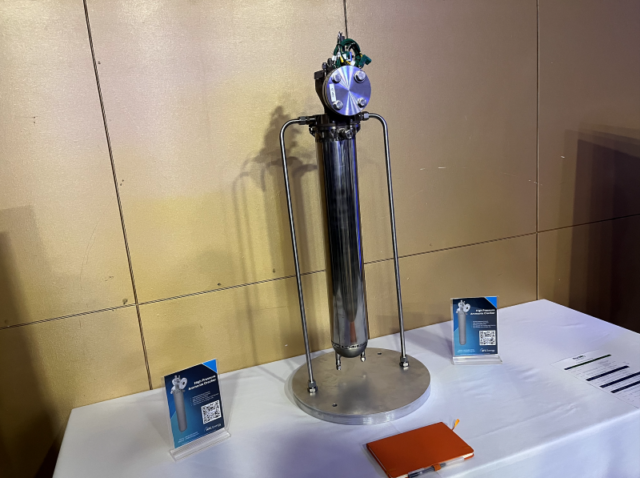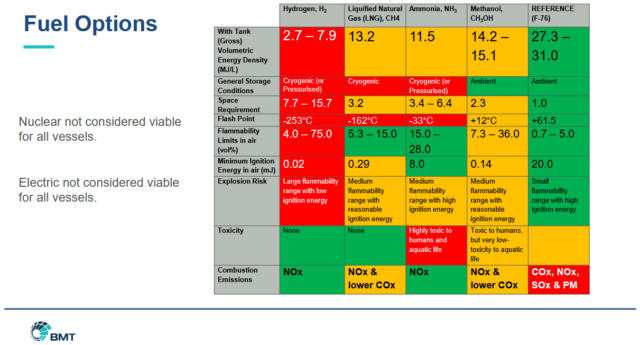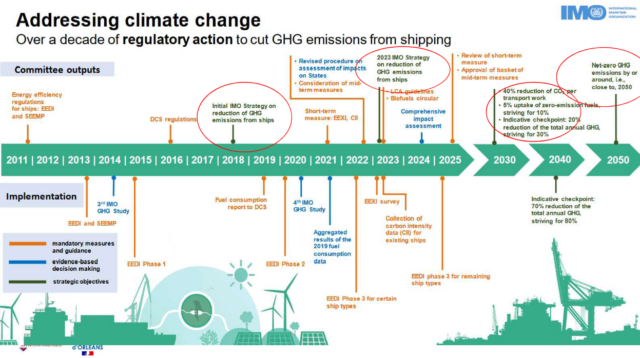Onboard cracking, fuel storage and adhering to emissions standards: highlights from the MariNH3 conference
By Geofrey Njovu on July 10, 2024
“Small but mighty” – ammonia crackers for heavy shipping decarbonisation
A balancing act

Click to enlarge: AFC Energy’s 20kg per hour ammonia cracker, on display at the 2024 MariNH3 conference in Nottingham. Source: Geofrey Njovu.
The 2024 MariNH3 conference opened with a keynote by Mike Rendall, the CTO of hydrogen and fuel processing at AFC Energy. AFC energy is a fuel cell manufacturer based in Cranleigh, UK and a member of the Ammonia Energy Association. The company has two main divisions, namely, fuel cell technology and fuel conversion technology. The company’s fuel cell technology offerings range from 10kW to 500kW.
In fuel conversion space, AFC has designed its own proprietary ammonia cracking technology. On display at the conference was an AFC ammonia cracker with an hourly processing capacity of 20 kg of ammonia (pictured right). According to the company, the cracker, operating at 20 bar pressure, can take multiple heat sources and has a built-in heat recovery system to maximise efficiency.

Click to enlarge. The ammonia cracking reaction is endothermic and is also favoured at lower pressures. However, low pressure slows the reaction kinetics. From Mike Rendall, Small – but Mighty: Decarbonising Heavy Shipping with Ammonia Crackers (MariNH3 conference, June 2024).
The keynote highlighted the fundamental challenge of the ammonia cracking reaction rooted in its endothermicity and the fact that it goes against the thermodynamic equilibrium. The reaction yield would be enhanced by high temperature and low pressure. However, low pressure affects reaction kinetics. Cracker design is therefore a balancing act between reaction yield and speed – as well as the application the system is being designed for.
Onboard cracking
The keynote also highlighted multiple marine projects in which AFC Energy is involved. First is AFC’s partnership with VARD and DNV to develop an integrated 2 x 600 kW ammonia cracker & fuel cell system. The design concept has already received Approval in Principle (AiP).
Secondly, AFC is part of Project ENTICE (Enhanced Ammonia Cracking To Improve Engine Combustion and Emissions) in partnership with the University of Nottingham, Clean Air Power and Mahle. Supported by UK government funding, the project seeks to explore the potential of a combined ammonia cracker & combined engine system.
This combined system would side-step the need for a separate purification step following ammonia cracking, a feature which – while sometimes necessary – adds to the cost and complexity of the system. The integrated design would also allow heat recycling from the exhaust which can be fed into the ammonia cracking component.

Click to enlarge. In-situ lab testing of a combined cracking & marine engine system. From Mike Rendall, Small – but Mighty: Decarbonising Heavy Shipping with Ammonia Crackers (MariNH3 conference, June 2024).
In-situ laboratory-scale testing of this system has commenced, with promising signs. Preliminary emissions data shows NOX levels comparable to a combustion engine running on 100% E10 fuel. These test engine emissions are also unabated, meaning that application of readily-available emissions mitigation technologies (such as selective catalytic reduction) would further reduce these NOX levels.
Further, AFC Energy is building up operations at the Compact UK Hydrogen Generation Facility to produce 400 kg per day of PEM fuel cell-grade hydrogen, making it the largest plant in the UK. It was highlighted that tours of the facility can be facilitated for interested parties. Mike Rendall’s full keynote presentation can be accessed on the MariNH3 website.
Ammonia fuel storage requirements
The closing keynote of the conference was delivered by Thomas Beard, Clean Shipping Service Lead at BMT. His presentation focused on the safety aspects of vessel design in relation to the adoption of new fuels such as ammonia. Specifically, the talk sought to answer the question: how do we safely bunker the new fuel onboard?
The hazards associated with gaseous ammonia fuel are well known, and it is important to ensure that ammonia-powered vessels are equipped with sufficient safety measures. Features such as segregated spaces, air locks, water curtains and alarms, safety stations and double-walled pipes and ventilation such as continuously operating fans should be included. Further, and of particular importance in passenger-carrying vessels, the fuel compartment must be as far away from the people as possible – with gas tight boundaries in between.
On ship safety, the keynote underscored the importance of adhering to the physics of stability. To achieve stability in small vessels for example, fuel tanks should be close to the bottom of the ship, allowing a lower centre of mass.

Click to enlarge. Variations in properties and hazards between different alternative fuels that are currently under consideration for shipping, with different options preferred in different settings. From Thomas Beard, Impact of Alternative Fuel on Vessel Design (MariNH3 conference, June 2024).
Throughout his talk, Dr Beard emphasised that in vessel design, minute modifications can have substantial impact, which is why the design process should take as much time and be as thorough as necessary. Regulation is important as its absence can lead to casualties which may negatively affect the perception of the technology, further stifling the potential for innovation and adoption.
Additionally, the keynote highlighted that with a move to ammonia, large volumes of the fuel will be required for ships. As such, fuel availability will be an important constraint, necessitating measures such as the formation of green corridors to ensure a functional supply chain. For more information, Thomas Beard’s full presentation can be accessed on the MariNH3 website.
Emissions from ammonia engines: after-treatment, adherence to Tier 3

Click to enlarge. A timeline of regulatory interventions by the IMO, culminating into the net zero emissions commitment from shipping by 2050. From Christine Rouselle, The Impact of Ammonia Engines on Global Atmospheric Pollution (MariNH3 conference, June 2024).
Delivering the middle keynote at the conference, Professor Christine Rouselle from Orleans University highlighted ammonia’s difficulties as a fuel, and the implications of these for engine emissions. Ammonia fuel has a low laminar flame speed when combusted, a small low heating value compared to methane, and is difficult to combust under cold-start conditions. To mitigate this, hydrogen can be used to enhance ammonia combustion, but this introduces its own set of emissions risks.
Ammonia fuel itself poses handling safety risks, while its potential combustion products N2O and NO2 pose climate and health risks, respectively. This necessitates after-treatment methods to minimise the amount of these exhaust gases emitted into the atmosphere. The composition of exhaust gases is affected by a mixture of other factors such as piston design, compression ratios, and enhancer gas concentration.
So what does the research say? The keynote explored data which estimated the NOX, NH3 and N2O emissions that would arise from powering the entire global shipping fleet with ammonia. The research compared two alternative scenarios: pure NH3 and NH3-H2 combustion. The first scenario leads to very high NH3 emissions (ammonia slip), while the second produces more NOX emissions. Further, although H2 increases combustion and thermodynamic efficiency, extra energy is needed to produce more H2, lowering the overall efficiency. After-treatment is required in both scenarios to minimise atmospheric emissions.
Some key takeaways from analysis of the data include:
- All ammonia-powered marine engines will require post-treatment methods such as NH3 scrubbing and selective catalytic reduction.
(author’s note: luckily, many of the technology methods are already available “off-the-shelf”, or will be able to be adapted from existing equipment)
- Although ammonia-powered ships would have lower tailpipe CO2, strict regulations should be put in place to mitigate adverse impacts.
- Adherence to existing Tier 3 NOX standards (ie. 3.4 g/kWh NOX emissions limit) – will help ensure that ammonia-powered ships will be more environmentally friendly than conventional shipping fuels.
- Pure NH3 fuel contributes more towards particulate emissions (PM2.5) than a NH3-H2 mixture. Mitigation of these emissions is crucial for atmospheric air quality.
For more information about Prof. Rouselle’s presentation, you can access the slides on the MariNH3 website.